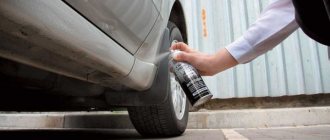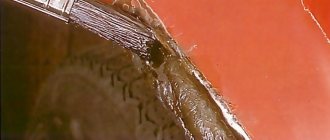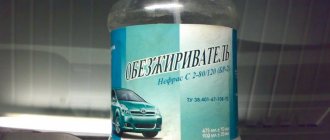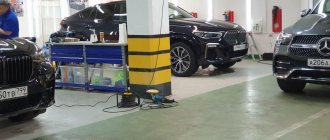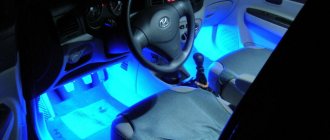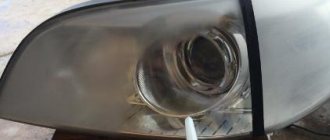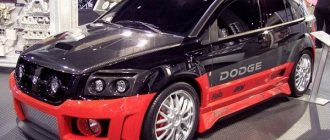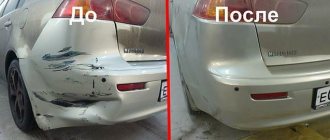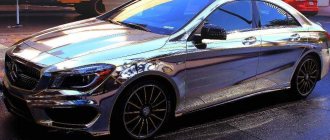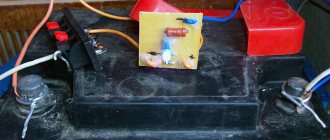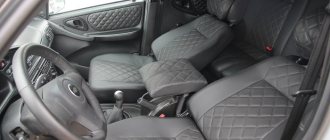Operating principle of the converter
All items made of iron and steel are highly durable and durable. Their only disadvantage is their susceptibility to corrosion, which can quickly, within 2-3 years, damage the metal part.
This problem is especially familiar to car enthusiasts:
under the influence of dampness and chemical road reagents, a coating of rust appears on unprotected metal parts of the body and suspension, which begins to corrode the metal.
To prevent this, special protective compounds against rust are used, which operate on two basic principles:
- Electrochemical protection. Based on the use of the principle of galvanic couples made of various metal materials. The main role here is played by the metal, which has greater chemical activity. It is first exposed to rust, as if taking upon itself the full blow of the aggressive action of the external environment. When destroyed, the active component neutralizes this effect on the metal part treated with a protective composition.
- Conservation method. This method of rust protection involves the formation of a thin protective film on the treated surface. This way, it is isolated from the action of aggressive external factors that cause corrosion. Both methods have their advantages and disadvantages. Thus, electrochemical protection is not effective enough without the simultaneous use of a conservation method.
The Tsinkar rust converter uses both of these methods of protection, which has significantly increased its effectiveness compared to many other products of a similar purpose.
The main components of the Tsinkar converter include salts of chemically active metals - zinc and manganese.
Additionally, it contains orthophosphoric acid, which, when interacting with the surface being treated, forms a thin protective film.
Manganese salts create an alloying effect, making the metal more resistant to destructive factors.
Zinc compounds interact with chemicals that cause rust, neutralizing them.
Thanks to its carefully calibrated composition, the Tsinkar rust converter is capable of not only protecting metal from corrosion, but also neutralizing existing sources of damage.
The drug destroys iron oxides, converting them into phosphates - neutral compounds that are absolutely not dangerous to the metal.
Monophosphate anti-corrosion agents do not have this effect.
Let's sum it up
The question of how to restore car body parts after corrosion damage is quite complicated. You can use various options for means, techniques and protection options. However, there are a number of difficulties in using professional methods - it is impossible to apply them in your own garage and do everything correctly. Rust converters help remove corrosion, but do not guarantee that the body will last a long time without problems. These materials are designed today and now to remove already damaged elements.
Next, you will have to treat the body to protect the exposed areas from further corrosion damage. Tsinkar is also not a panacea for all types of body diseases.
It only removes rust well and copes well with large damages. Otherwise, it is a fairly simple product with high chemical activity. If used incorrectly, negative consequences are quite possible.
Area of use
"Tsinkar" is intended to protect against rust any structures exposed to aggressive substances - primarily dampness. This is a wide range of metal products used outdoors.
According to the instructions on the package, the converter is suitable for processing a wide range of metal products:
- Car garages, kiosks, boxes;
- Power line supports;
- Load-bearing structures of metal bridges;
- Fencing and decorative gardening structures.
“Tsinkar” will be especially useful for car owners. Operating a car, even in the city, always occurs in difficult conditions.
Constant dampness, an atmosphere filled with aggressive chemicals, and reagents on the roads lead to corrosion on the elements of the car body and suspension. Often, even a protective factory coating cannot save you from it: the slightest scratch, and rust begins its destructive work. This can be avoided by promptly treating the damaged area with a layer of Tsinkar.
The anti-corrosion agent comes on sale in several versions:
- Small bottles, with a capacity from 60 ml to 1 liter;
- Bottles of the same capacity, but equipped with a spray nozzle;
- 10 liter canisters, used when it is necessary to treat large surfaces.
Application order
Before applying “Tsinkar”, the surface to be treated is pre-prepared.
Preparation consists of thoroughly cleaning the corroded area from loose particles of rust and old paint. To do this, you can use a spatula, a stiff brush, a large emery cloth, or just a knife.
Next, you need to prepare the rust converter itself for application. Over time, a sediment inevitably forms at the bottom of the container, which is formed by dissolved metal salts. Therefore, the bottle or canister containing “Tsinkar” must be shaken thoroughly, and only then applied to the surface to be treated.
All working components included in the anti-corrosion agent will be evenly distributed throughout the entire volume.
You can paint a surface affected by rust with a simple brush or roller. True, in these cases the material consumption increases.
To save money, it is recommended to use rust converter bottles equipped with a spray nozzle.
In a situation where you need to treat a large surface area, you can use a paint spray gun. This will allow you to apply the product in a thin, even layer.
The average consumption of anti-rust agent is up to 350 ml per m2 when applied in one layer.
It is allowed, to enhance the protective effect, to apply anti-corrosion liquid in two or three layers. In this case, the next layer is applied only after the previous one has completely dried.
The drying time of the layer depends on the temperature and humidity of the surrounding air. On average, this is half an hour to 1.5 hours - drying can be judged by the appearance of a grayish-white coating.
Fluid flushing
After finishing working with the anti-corrosion agent, you should wait for it to dry completely and wipe the application area with a dry rag. The remaining gray or white coating on the surface can be removed with a special silicone-based remover, organic solvents (white spirit, acetone) or simply with a rag or sponge dipped in warm water.
You should not be too zealous when washing off excess product - this can damage the thin protective layer formed on the surface, which protects it from rust.
If the treated part is planned to be painted in the future, then washing is not necessary.
How long does it take for Tsinkar to dry?
If painting is carried out in a room at room temperature, the time required to dry the layer will be half an hour to forty minutes. Drying time may also be affected by the type of application and climatic conditions. Some experimenters resort to blow-drying, but it is better not to conduct such experiments. After all, heating the solution above +55 degrees is not permissible.
Drying time may be affected by type of application and climatic conditions.
Precautionary measures
The anti-corrosion agent contains orthophosphoric acid, which is a flammable and toxic chemical. Therefore, it is necessary to work with this liquid in well-ventilated areas. You must wear rubber gloves on your hands, and a respirator or cotton-gauze bandage on your face.
If the substance gets on the skin and mucous membranes, these areas must be rinsed with plenty of running water.
If a burn or allergic reaction occurs, you should immediately contact a medical facility. The liquid should be stored out of the reach of children.
With timely and correct use of Tsinkar, you can effectively protect any metal surface from corrosive damage. The need for protection becomes especially urgent when we consider that corrosion can quickly damage a part or element of a metal structure, the price of which is hundreds of times higher than the cost of a bottle of anti-corrosion liquid.
Source
Advantages and disadvantages
To make an informed choice of a suitable rust converter, you need to know in advance all its pros and cons.
The advantages of the product include:
Efficiency.- Creation of a protective coating.
- Convenient application.
- Possibility to select the volume of purchased product.
- Absence of flammable components.
- Democratic price.
- Recognizable packaging.
- Economical consumption.
The disadvantages include:
- Toxicity of the product.
- The need to use protective equipment during work.
- The need to re-coat with Zinkar, and in case of deep rust - multiple times.
- The chemical activity of the drug is not only in relation to rust, but also to varnishes and paints.
Main varieties
If we talk about such means, then, first of all, we should highlight the following types:
- rust converter with zinc. At the moment, such substances are the most popular. They are characterized by almost instantaneous action and high efficiency. They offer increased protection against further rust. At the same time, before using them, you need to treat the surface with sandpaper, and then with a zinc solution. The product itself is used when the surface acquires a gray tint. It will take you longer than with other remedies, but it's worth it;
It may also be interesting: The alarm does not respond to the key fob, what should I do?
- acid agents. An old and proven method that is extremely useful and effective. The main advantage is simplicity and speed of use. We simply clean the area where rust has developed, and then apply the solution there. It is important to calculate the time correctly so as not to overexpose the product, but also not to eliminate it in advance. In general, here you need to follow the instructions;
- rust converter into soil. This is a fairly new modification that helps transform corrosion into soil. At the same time, according to reviews, the use of such solutions is not the safest idea, because the substance can damage the paintwork near the source of corrosion.
We recommend: After washing the engine does not start. What to do?
Compound
Zinkar's composition includes the following components:
- phosphoric acid;
- complexing agent;
- manganese and zinc compounds;
- water.
Phosphoric acid is the main active ingredient responsible for the transformation of rust. The complexing agent maintains the consistency of the drug and is a binding component.
Phosphates form a reliable protective coating on the surface:
- zinc protects against electrochemical corrosion;
- manganese is responsible for surface alloying.
Types of rust modifiers
The industry produces rust converters for the following types of cars:
- Zinc. All zinc-based preparations are popular. The deposited layer of zinc on the car body prevents the recurrence of corrosion. Before performing the operation, the rusty surface is cleaned, sanded and treated with an electrolytic zinc solution. Experts note that the optimal time for applying a zinc rust converter is the moment a gray coating appears on the metal.
- Acidic. Such preparations prevent the development of corrosion at the initial stage. This is important because the car body is usually made of thin metal. If the rust process is started, the part quickly rots and through corrosion can form. As a result, expensive elements will have to be replaced. If a section of the body is coated with this modifier, a layer of corrosion simply will not form and the driver will not have to change the fender liners or hood cover over time.
- Converters of rust into soil. These are new generation modifiers. Unlike products produced on the basis of orthophosphoric acid, they do not create a protective layer on the metal, but convert rust into a primer. These primers are popular abroad, but in Russia, car enthusiasts tend to choose between products based on zinc or acids.
We recommend: What to do if the starter turns, but the car does not start?
How to use - instructions for use
In order for the Tsinkar converter to work and the processing to be of high quality, you must follow the instructions for use. The drug is available in bright orange packages. The 0.5 l volume has an ergonomic shape and is equipped with a sprayer, allowing you to quickly and easily treat a large area.
Procedure:
- Clean off remaining paint and loose rust from the metal, and remove dirt.
- If the surface is stained with oily compounds, degrease.
- Shake the bottle. This is necessary because Tsinkar can form sediment.
Apply generously in a convenient manner over the entire corroded area. For packages with a sprayer, the best option is to spray over the entire area that needs treatment. You can also use a brush, roller or sponge.- Allow sufficient time for the composition to dry on the metal.
- Process the metal using a stiff hair brush. At this stage, loose fragments and product residues that have not reacted are eliminated.
- Repeat application of the converter.
- Allow time to dry completely again.
- Brush with a hairbrush or stiff brush. Removing the resulting plaque by washing is necessary in order for the processing efficiency to become higher.
Analogs
In order to cope with rust, you can use other anti-corrosion drugs. Among the market leaders are converters of domestic and foreign production.
Sonax Rost Umwandler&Grundierung
Sonax is a rust preventative that is designed for minor body work and to combat corrosion on small areas of metal. This product works well when it is necessary to loosen nuts and bolts.
The composition of the converter is selected in such a way that it can be used even on areas covered with paint. Despite this, Sonax is toxic.
After drying on the metal surface, the product forms a polymer protective film . It can serve as a primer before applying paint.
When purchasing Sonax, keep in mind that the packaging is small and multiple bottles may be needed for extensive work. The cost of one is from 230 rubles.
Chainmail
Chain mail is a product of a domestic manufacturer. The product contains zinc, which creates a protective coating. The converter fights corrosion well and protects the metal.
There are no acids in Kolchuga . Serving as a primer at the same time, this product does not require rinsing before applying paint.
Another important plus is the affordable price. The cost of one bottle is around 130 rubles.
Hi-Gear Rust Treatment
Not every rust converter can cope with severe corrosion. But Hi-Gear successfully removes damage. The bottle is equipped with a sprayer, which allows you to treat even large areas of metal very quickly. As a result of the reaction, corrosion is eliminated, and a polymer layer is formed on the metal surface.
Hi-Gear must be used carefully, protecting the respiratory tract and avoiding contact with painted areas . The converter requires washing, not just with water, but with an alcohol-containing solvent.
This effective remedy is not cheap - 700 rubles.
Astrohim
Price 140 rubles.
The rating of the rust converter of the domestic company AstroChem continues. This is a budget analogue of foreign products in the low price segment. A half-liter container is enough for a decent area of metal.
The classic composition is supplemented with highly effective additives, zinc ions, which guarantees an impeccable work result, plus it has the property of restoring microcracks.
The second part of the formula, orthophosphoric acid, has an active effect directly on the source of rust, completely neutralizing the harmful manifestation. Also pleasing is the ease of subsequent processing - just wipe the surface thoroughly with special towels, then the preparation forms a galvanized layer.
Before painting, it is recommended to thoroughly remove the cleaner from the surfaces to be painted. Such parameters guarantee the possibility of gentle removal of defects in body parts.
Advantages:
- minimum price tag;
- worthy fulfillment of assigned tasks;
- large bottle volume.
Flaws:
Meticulous removal of the layer is required before painting.
User reviews
Users who use Zinkar to eliminate corrosion note its effectiveness, the creation of a protective layer and its low cost. Opinions about quality and effectiveness vary.
Car enthusiasts note that the drug has disadvantages:
- toxic;
- there is a pungent odor;
- requires very careful use;
- cannot be left without rinsing;
- not compatible with paint and varnish coatings.
Reviews can be found on this review site and here.
You will find all the most important and useful information about rust converters in this section.
How much to apply
The number of layers affects the effectiveness of the barrier layer, so savings are not advisable here. The minimum application is two layers, but for more reliable protection of items that have frequent contact with negative natural influences, it is better to use more layers.
The thickness of the layers is normal; there is no need to heavily paint the surface. When a spray is used, the layer thickness will be distributed optimally.
The number of layers affects the effectiveness of the barrier layer, so savings are not advisable here.
